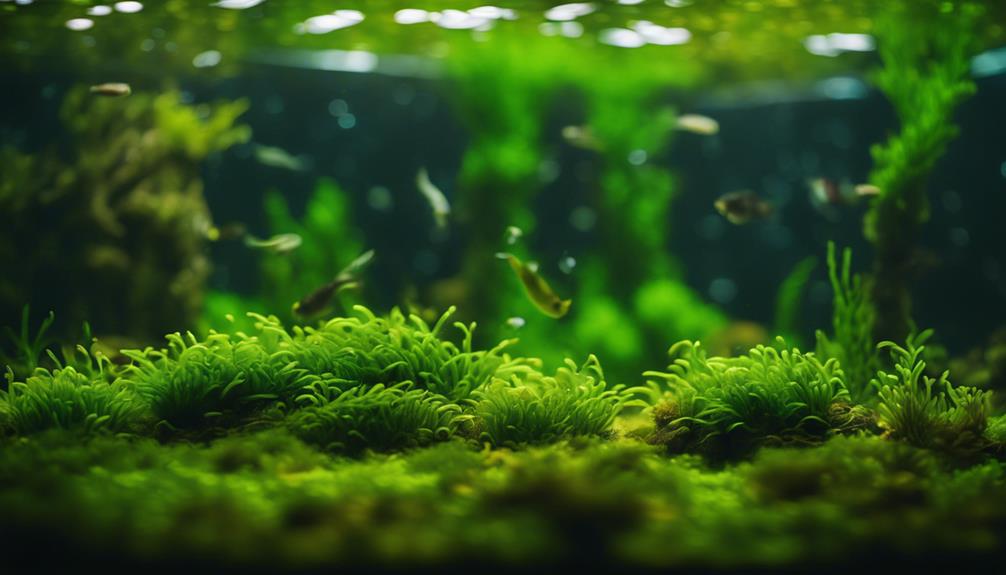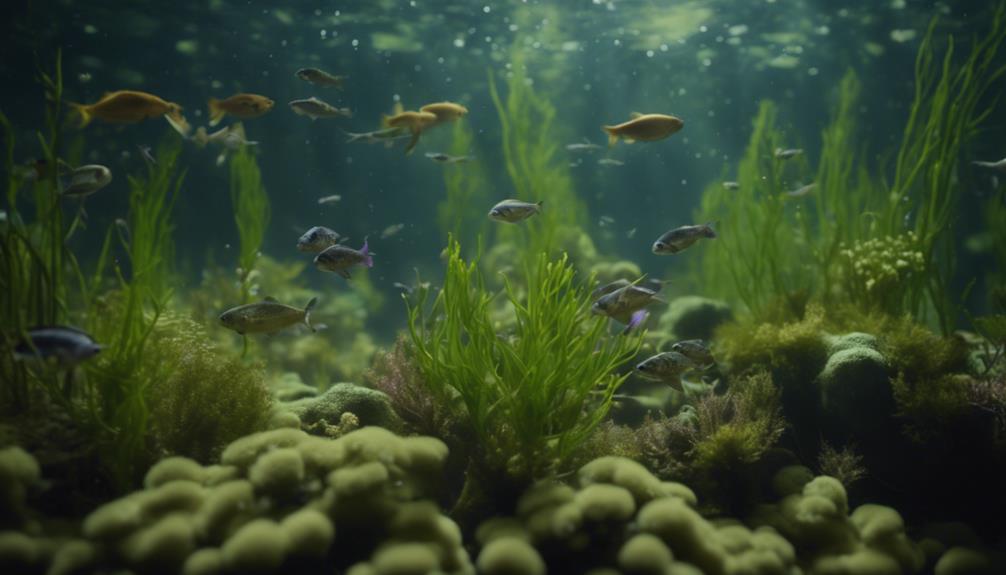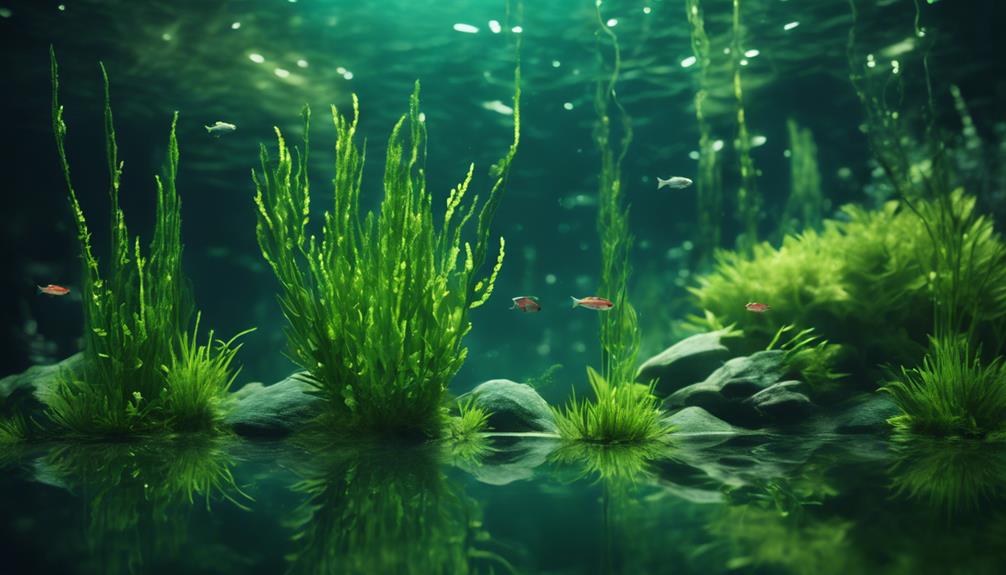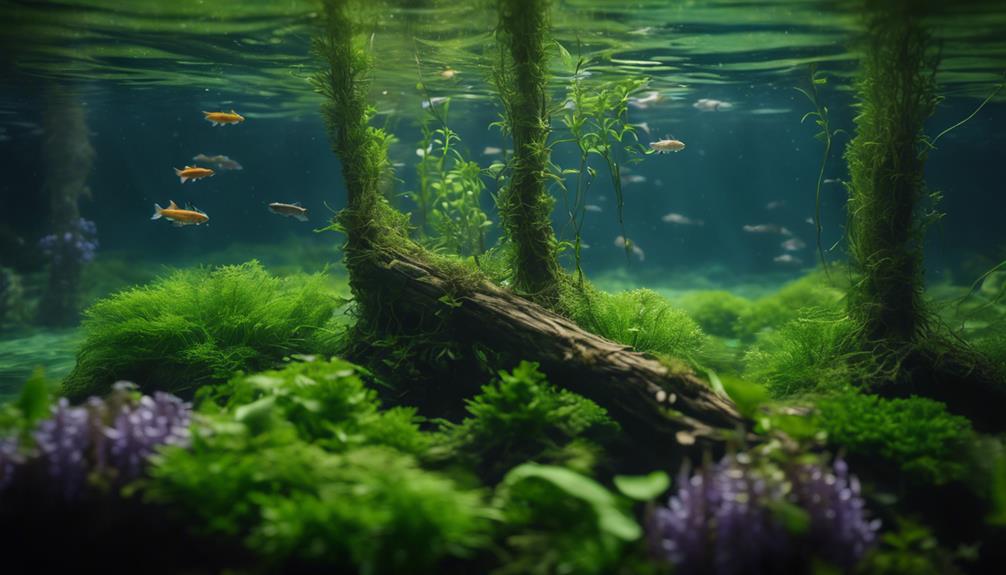You need a mix of aquatic plants to maintain a healthy ecosystem. Cabomba, Hygrophila, and Egeria densa are essential stem plants for height and texture. For ground cover, use carpeting plants like Dwarf Baby Tears, Micranthemum 'Monte Carlo', and Glossostigma elatinoides. Floating plants like Water Hyacinth and Duckweed provide surface coverage and maintain water quality. Mid-water plants like Cabomba and Hygrophila polysperma add texture and depth. Background plants like Amazon Swords and Java Ferns create hiding places for fish. Finally, oxygenating plants like Anacharis and Water Wisteria release oxygen and absorb carbon dioxide. Now that you've begun to explore the importance of diverse aquatic plants, you'll discover how each plays a crucial role in maintaining ecosystem balance.
Table of Contents
Key Takeaways
- A balanced mix of aquatic plants provides oxygenation, nutrient uptake, shelter, and food for aquatic life, maintaining ecosystem balance.
- Incorporating plants with varying growth rates and light requirements guarantees adequate coverage and filtration in the aquarium.
- Stem plants like Cabomba, Hygrophila, and Egeria densa add height, variety, and visual interest to high-tech aquariums, creating a dynamic environment.
- Carpeting and mid-water plants like Dwarf baby tears and Micranthemum 'Monte Carlo' create a dense, green carpet, adding texture and depth to the underwater landscape.
- Floating and oxygenating plants like Water hyacinth and Anacharis provide essential shade, reduce algae growth, and maintain a healthy environment in the aquarium.
Balanced Aquatic Plant Selection
When designing an aquarium or pond, you should prioritize selecting a diverse range of aquatic plants that provide a balanced mix of functions, including oxygenation, nutrient uptake, shelter, and food for aquatic life.
This balanced ecosystem is vital in maintaining a healthy environment for your aquatic life.
By incorporating a mix of aquatic plant species, you'll improve water quality by absorbing excess nutrients, reducing carbon dioxide levels, and providing habitat for aquatic life.
As you choose your plants, consider their role in maintaining a balanced ecosystem.
Select plants with varying growth rates and light requirements to guarantee adequate coverage and filtration.
This diversity will also help you monitor nutrient levels and prevent the dominance of a single species.
By doing so, you'll create a thriving ecosystem where plants grow harmoniously, supporting a balanced and resilient environment.
Regular pruning and maintenance will help maintain this balance, guaranteeing a healthy and visually appealing aquascape.
Essential Stem Plants for Height
As you design your high-tech aquarium, you'll want to ponder incorporating essential stem plants that add height, variety, and visual interest.
By selecting plants with varying heights and textures, you can create a dynamic, layered environment that engages the viewer and provides habitat diversity for your fish.
From Cabomba's towering 60 cm stems to Bacopa's more compact 20-30 cm growth, you'll find a range of options to suit your aquarium's unique needs.
Adding Height Variety
To create a visually stunning aquascape, you can incorporate essential stem plants that provide height variety, adding depth and dimension to your high-tech planted aquarium. By incorporating these plants, you'll create a thriving aquatic environment that provides habitat and food for aquatic life.
Use plants like Cabomba, Hygrophila, and Egeria densa that can grow up to 20-30 inches tall to create a visually appealing background.
Train stem plants like Rotala and Ludwigia to grow vertically using plant weights or trellises, creating a sense of depth and dimension.
Use plants with tall, slender stems like Vallisneria and Egeria to create a natural-looking 'forest' effect in the background of the aquarium, providing shelter and habitat for fish.
Texture and Color
By incorporating essential stem plants that provide varying textures and colors, you can add depth and visual interest to your aquascape, creating a thriving ecosystem that supports aquatic life. These plants provide a range of textures, from delicate and feathery to dense and compact, adding beauty and aesthetic appeal to your aquarium.
| Plant | Texture and Color |
|---|---|
| Cabomba | Delicate, feathery leaves with a greenish-yellow color |
| Rotala rotundifolia | Rounded leaves with a vibrant green color |
| Hygrophila polysperma | Lance-shaped leaves with a reddish-brown color |
| Egeria densa | Dense, dark green leaves |
| Bacopa caroliniana | Small, rounded leaves with a light green color |
Carpeting Plants for Ground Cover

You can achieve a stunning ground cover in your high-tech aquarium by selecting carpeting plants that thrive in intense lighting and CO2 supplementation. These plants are ideal for creating a lush, dense ground cover, and with proper care, they can transform your aquarium into a natural-looking environment.
Three popular carpeting plants worth examining:
- Dwarf baby tears (Hemianthus callitrichoides): A popular choice for high-tech aquariums, requiring intense lighting and CO2 supplementation to thrive.
- Micranthemum 'Monte Carlo': A fast-growing carpeting plant that can create a dense, green carpet in high-tech aquariums with intense lighting and CO2 supplementation.
- Glossostigma elatinoides: A low-growing, fast-spreading carpeting plant that requires intense lighting and CO2 supplementation to thrive in high-tech aquariums.
To achieve a uniform carpet, plant them densely with individual stems spaced about 1-2 inches apart, and provide a nutrient-rich substrate to support their rapid growth.
Regular trimming is vital to maintain the desired shape and prevent these plants from growing too tall.
Floating Plants for Surface Coverage
As you explore the benefits of floating plants for surface coverage, you'll discover their ability to provide essential shade, reduce algae growth, and maintain a balanced ecosystem.
You'll learn about the unique benefits of water hyacinth, such as its rapid growth rate and ability to reduce water temperature.
Surface Shade Providers
Floating plants, such as Water Hyacinth and Duckweed, excel at providing surface shade, a crucial element in maintaining ecosystem balance by reducing algae growth and water temperature fluctuations.
By blocking sunlight, these plants prevent excessive light penetration, which can fuel algae blooms.
Reduced algae growth: By limiting light availability, surface shade providers prevent algae from overgrowing and dominating the ecosystem.
Stable water temperature: Surface shade helps regulate water temperature, creating a more consistent habitat for aquatic life.
Shelter for fish: Dense mats of floating plants like Water Lettuce provide shelter and protection for fish, making them feel safe and secure.
As you introduce surface shade providers into your aquarium, you'll notice a significant improvement in water quality and ecosystem balance.
Water Hyacinth Benefits
One of the most effective floating plants for surface coverage, Water Hyacinth provides a multitude of benefits that contribute to a thriving aquatic ecosystem. As a fast-growing plant, it can double its biomass in as little as 2 weeks, making it an effective tool for controlling algae blooms and maintaining ecological balance.
Here are some of the key benefits of Water Hyacinth:
| Benefits | Description |
|---|---|
| Habitat Creation | Provides shelter and food for small aquatic organisms, such as fish and invertebrates |
| Algae Control | Absorbs excess nutrients, reducing algae growth and improving water quality |
| Phytoremediation | Absorbs heavy metals and other pollutants from the water, promoting a healthier environment |
Duckweed Applications
You can effectively utilize duckweed as a versatile tool for maintaining ecological balance in aquatic environments, thanks to its remarkable ability to provide extensive surface coverage and absorb excess nutrients.
As a natural water purifier, duckweed plays a vital role in improving water quality and clarity by removing pollutants and heavy metals from the water.
This, in turn, helps to prevent algae growth and maintain a balanced aquatic ecosystem.
Providing shelter: Duckweed's dense cover provides a safe haven for aquatic animals, protecting them from predators and harsh water conditions.
Food source: As a rich source of protein and nutrients, duckweed serves as a natural food source for fish, birds, and other aquatic animals.
Natural water purifier: Duckweed's rapid nutrient absorption capabilities make it an effective tool in controlling algae growth and maintaining water quality.
Mid-Water Plants for Texture

By incorporating mid-water plants like Cabomba and Hygrophila polysperma into your aquarium, you can add an enchanting layer of texture and depth to the underwater landscape. These plants thrive in high-tech aquariums with intense lighting and can grow up to 2 inches per week, requiring regular pruning to maintain shape and promote healthy growth.
| Mid-Water Plant | Growth Rate | Benefits |
|---|---|---|
| Hygrophila polysperma | Moderate | Provides excellent cover, helps control algae |
| Anacharis | Fast | Absorbs excess nutrients, prevents algae growth |
| Bacopa caroliniana | Moderate | Creates a layered, dimensional appearance |
As you introduce mid-water plants to your aquarium, remember they play a crucial role in supporting biodiversity and ecological balance. They provide shelter and habitat for small fish and invertebrates, while also helping to absorb excess nutrients and prevent algae growth. To guarantee their ideal growth, regular monitoring of CO2 and nutrient levels is essential. By providing the right conditions, you'll be creating a natural, thriving environment where your plants and fish can flourish together.
Background Plants for Hiding Places
As you design your aquarium's layout, incorporating tall, broadleaf background plants like Amazon Swords and Java Ferns creates an ideal environment for fish to hide and feel secure. These plants can grow up to 12 inches tall, creating a natural barrier for fish to hide behind and feel secure.
By using a combination of background plants with different textures, colors, and growth habits, you can create a visually appealing and functional environment that meets the needs of your fish.
Background plants can create hiding places for your fish in three ways:
Dense foliage: Plants like Water Wisteria and Hornwort can be used to create a natural 'wall' in the aquarium, providing hiding places and territories for fish.
Natural barrier: Plants with large leaves, such as Anacharis and Cabomba, provide a sense of security for fish by blocking their line of sight.
Visual effect: Planting background plants with varying textures and colors can add visual interest and create a dynamic, natural-looking aquascape.
When choosing background plants, consider the light requirements of the species, as some plants like Cryptocorynes require lower light levels, while others like Anacharis can thrive in high-light conditions.
Oxygenating Plants for Water Quality

While creating hiding places with background plants is essential for your fish's well-being, incorporating oxygenating plants into your aquarium design takes water quality to the next level. These plants play a pivotal role in maintaining a healthy environment by releasing oxygen and absorbing carbon dioxide. By choosing the right plants, you can improve water quality and create a balanced ecosystem.
| Oxygenating Plant | Benefits |
|---|---|
| Anacharis | Absorbs carbon dioxide, releases oxygen up to 10 ppm |
| Cabomba | Oxygenates water up to 24 hours a day, reduces algae growth |
| Water Wisteria | Oxygenates water, provides shelter and food for aquatic animals |
| Hornwort | Fast-growing, absorbs excess nutrients, stabilizes water parameters |
| Java Moss | Oxygenates water, provides shelter and food for aquatic animals |
Oxygenating plants help create a healthy environment by reducing algae growth, improving water circulation, and providing a natural food source for herbivorous fish and invertebrates. Their roots help absorb excess nutrients, preventing algae blooms. By incorporating these plants into your aquarium, you'll be taking a pivotal step in maintaining water quality and creating a thriving ecosystem.
Frequently Asked Questions
How Do Aquatic Plants Help the Ecosystem?
You discover that aquatic plants play a vital role in maintaining ecosystem harmony by facilitating water purification, oxygen production, and carbon sequestration, while also creating habitats, serving as a food source, and controlling erosion.
What Do Plants Provide Fish With in a Balanced Aquarium?
You're fundamentally giving your fish a luxurious aquatic resort when you add plants, providing them with a plethora of benefits, including abundant food sources, shelter spaces, oxygen supply, water clarity, nutrient uptake, toxin removal, pH balance, temperature regulation, habitat creation, and visual barriers.
What Plants Grow in an Aquatic Ecosystem?
You'll find a diverse range of plants thriving in an aquatic ecosystem, including freshwater species like water lilies, submerged vegetation, and lake algae, as well as saltwater flora like ocean seaweed, marine kelp, and aquatic blooms.
How Many Plants Should I Have in My Aquarium?
Imagine a 10-gallon aquarium with a mix of plants like Java moss and Amazon swords. You'll want to allocate space wisely, aiming for 1-2 plants per gallon, depending on the species, to guarantee a balanced biological environment and maintain ecosystem harmony.
Conclusion
You've carefully selected a diverse range of aquatic plants to create a thriving ecosystem.
But have you considered the impact of an unbalanced plant community on your aquatic friends?
Without essential stem plants, carpeting plants, floating plants, mid-water plants, background plants, and oxygenating plants, your tank's delicate balance can be disrupted.
By incorporating these seven aquatic plants, you'll create a harmonious environment where your aquatic life can flourish.
Can you really put a price on the well-being of your underwater world?

